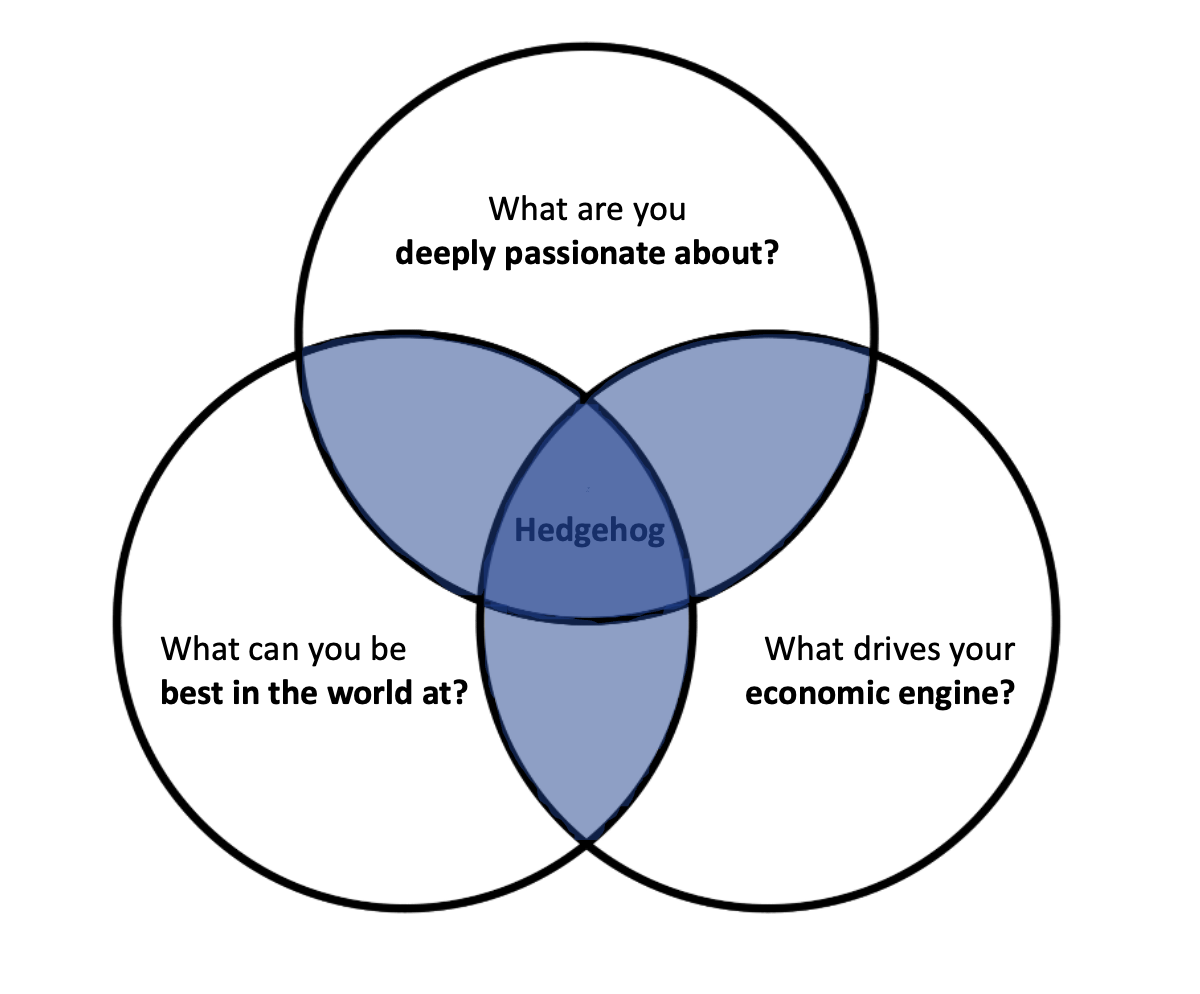If you are like me, you have read Good to Great by Jim Collins multiple times. Chances are you also have a special place on your bookshelf reserved in perpetuity for this great book. What's more, there is a good chance we both can recite the major tenants of this timeless book. And chances are you are also thinking, "I should have adopted the major tenants of this powerful book long ago."
You are in luck...Now is always an ideal time to make substantive change.
This piece has long been in my mind and sets out to briefly explore the deep roots of Jim Collins' Hedgehog Concept... Let's begin by briefly going way back to a simple ancient Greek parable (written by the poet Archilochus) which offered profound insights for today's entrepreneurs and business leaders: "The fox knows many things, but the hedgehog knows one big thing."
Archilochus' metaphor, which captures the essence of strategic focus versus broad knowledge, was later explored via Isaiah Berlin’s 1953 essay "The Hedgehog and the Fox," and more recently further applied to the business world by Jim Collins through his seminal work "Good to Great."
There is good news. Collins spent time with Peter Drucker, and Drucker's foundational management principles provide the underlying wisdom that reinforces the importance of this concept. This is the foundation that forms the Hedgehog Concept, a truly transformative approach for those seeking not just to grow, but to thrive.
Philosophical Roots and Business Evolution
Isaiah Berlin’s "The Hedgehog and the Fox" illustrates the divergent worldviews of two distinct types of thinkers. The fox, with its cunning, knows many things - navigating the world through a wide variety of truths loosely held. In contrast, the hedgehog understands the world through a single, unifying idea. Jim Collins, inspired by Berlin’s essay, saw a direct application of this dichotomy in the business world. Collins argued that companies transition from good to great not by diversifying their knowledge and efforts but by focusing intensely on one big thing - their core competency.
Check out Jim Collins' FC article - Good to Great. Focus on the section titled "Disciplined Thought: Fox or Hedgehog?". It is concise and brilliant.
Peter Drucker, often considered the father of modern management, laid much of the groundwork for Collins's Hedgehog Concept. Drucker’s insistence on the importance of organizations focusing on their strengths coupled with his belief in management by objectives, resonate with the hedgehog’s singular focus. Drucker famously articulated that "efficiency is doing things right; effectiveness is doing the right things," a sentiment that underscores the Hedgehog Concept’s call for strategic depth over breadth.
Understanding the Hedgehog Concept
Jim Collins’ Hedgehog Concept is articulated around three pivotal questions that compel organizations to scrutinize their operations, market position and internal passions:
- What can you be the best in the world at? This question challenges organizations to critically assess their unique strengths and capabilities. It is not about fostering unrealistic ambitions but about identifying where they can truly excel and differentiate themselves from the competition.
- What drives your economic engine? Collins emphasizes the need for a clear economic metric that defines success. Whether it is profit per x or another measure, understanding this driver focuses efforts on what financially sustains and propels the business forward.
- What are you deeply passionate about? Passion fuels perseverance. For a strategy to be sustainable, it must align with the organization's core values and interests - ensuring long-term commitment and resilience.

The convergence of these three circles - being the best, economic drivers and passion - defines the sweet spot for organizational excellence. It is where companies find their "big thing" and focus their resources - setting the stage for transformative success.
This drawing / The Hedgehog Concept is attributed to the great Jim Collins. And... And I am proud to say that I spent much more time than I care to admit drawing this graphic.
The Power of Focus in Business Strategy
The application of the Hedgehog Concept requires unwavering focus and discipline, qualities that Peter Drucker emphasized in his teachings. The strategic alignment of an organization’s core competencies with its economic drivers, underpinned by genuine passion, creates a formidable foundation for success. Drucker's influence is evident in the concept's emphasis on doing what you do best and aligning every decision, every project, and every initiative to that central focus.
Implementing the Hedgehog Concept
To translate the Hedgehog Concept from theory into practice requires a disciplined, methodical approach. First, leaders must engage in a process of profound introspection and market analysis to identify their organization's core competency. This involves asking tough questions, gathering and analyzing data and perhaps most importantly, being willing to listen to the at times hard truths about what the organization truly excels at and where its passions lie.
1. Conduct a Rigorous Self-Assessment
This step is about looking inward and outward. Internally, it involves understanding your strengths and passions. Externally, it means analyzing the market to identify where your organization's unique value proposition meets customer needs in a way that no other company can match. Tools like SWOT analysis (Strengths, Weaknesses, Opportunities, Threats) can be instrumental in this phase.
2. Identify Your Economic Engine
Peter Drucker’s assertion that "what's measured improves" rings true here. Identifying the single most important economic metric — be it profit per customer, profit per transaction, or something else — focuses the organization's efforts on what truly drives financial success. This clarity allows for more informed decision-making and strategy development.
3. Align with Passion
Passion is the fuel that keeps the engine running, particularly during tough times. Aligning the organization's efforts with what its people are deeply passionate about ensures not just commitment but also creativity and innovation. This alignment makes the work more meaningful and, by extension, more likely to produce exceptional results.
Challenges and Considerations
The journey towards implementing the Hedgehog Concept is not without its hurdles. Resistance to change is a common challenge, as is the temptation to chase after new, seemingly lucrative opportunities that do not align with the organization's core focus. Overcoming these challenges requires a clear vision, strong leadership, and a commitment to the disciplined pursuit of what the organization defines as its "big thing." Collins argues that this journey requires disciplined people, disciplined thought and disciplined action (review The Map - Jim Collins).
Navigating Cultural Resistance
Changing the direction of an organization, especially if it means narrowing its focus, can meet with resistance from within. Leaders must communicate the value of the Hedgehog Concept clearly AND OFTEN. Leaders must demonstrate how it aligns with the organization's long-term success. This often involves cultural shifts that prioritize depth over breadth and excellence over diversification.
Maintaining Flexibility Within Focus
Adopting the Hedgehog Concept does not mean being inflexible. Markets change, new technologies emerge and customer preferences evolve. Organizations must remain adaptable, ready to refine their focus as needed while staying true to their core competency, economic driver, and passion.
A Call to Action
If you are like most business leaders scaling your business, you are busy putting out fires and driving profitable revenue while building the plane as you fly.
Bluntly. The choice is yours. This is your moment to get intentional about your future and bring order to the chaos. Right now is precisely the right time to slow down to speed up.
For business leaders and entrepreneurs committed to not just growth but sustained excellence, the Hedgehog Concept offers a compelling framework. It is truly a call to move beyond the scattered, unfocused efforts that dilute potential and to embrace a concentrated strategy that leverages true strengths.
Now is the time to embark on a journey of self-discovery, to align your organization's strategy with its deepest strengths and passions, and to focus relentlessly on what drives your economic engine. This is not just a strategy for success; it's a blueprint for greatness.
Be the Hedgehog...
The Hedgehog Concept, grounded in ancient wisdom and brought to life by the insights of Isaiah Berlin, Jim Collins and the late, great Peter Drucker, provides a powerful model for business leaders seeking to transform their organizations. By focusing on what you can be the best at, what drives your economic engine, and what you are deeply passionate about, you can unleash the full potential of your organization. Your path to greatness is marked by clarity, focus and discipline — qualities that the Hedgehog Concept brings into sharp relief. Embrace this concept and embark on a journey to not just success but enduring greatness.
Take a few minutes and read the following FC article - Good to Great. Jim Collins speaks of the Fox and the Hedgehog. Pure brilliance.
Check out Ten Lessons I Learned From Peter Drucker by Jim Collins. Also consider checking out Jim Collins' interviews on YouTube.
Chris Young is a Trusted Advisor To Founders / CEOs | Certified Scaling Up Coach | Builder of People, Leaders, Teams & Economic Moats | Strategist and proud founder of The Rainmaker Group.




